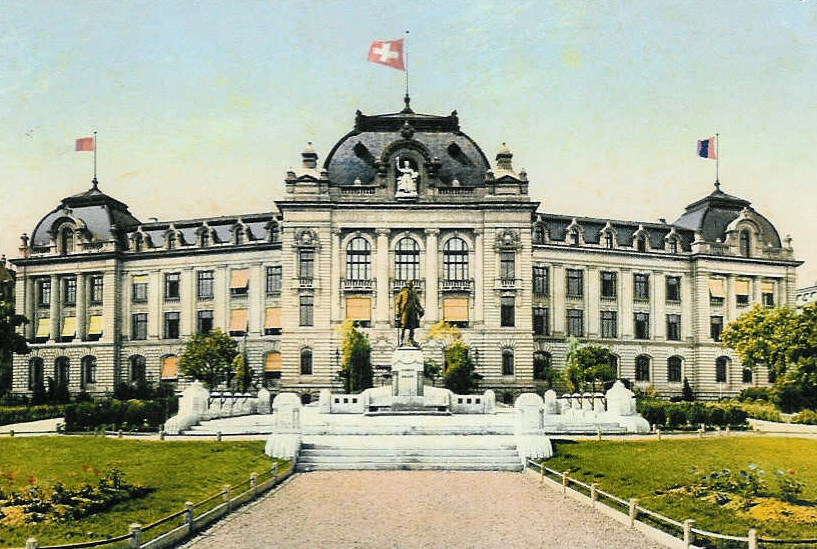History of the university
Early history - from the "Hohe Schule" to the Academy (1500-1834)
The foundations of the University of Bern were laid in the 16th century, when the Reformation made it necessary for new priests to be educated in a higher education establishment. In 1805, as part of the reorganization of higher education, the Bern government converted the former School of Theology into an Academy with four faculties. Thus, not only ministers but also lawyers and physicians could complete their entire education in Bern.
The old university - new beginnings and growth (1834-1900)
In the struggles between Conservatives and Liberals during the regeneration, 1831 saw the Liberals gain victory in the Canton of Bern. Under their administration, the Academy was transformed into a university in 1834. 45 lecturers provided education to 167 students. The new administration relied upon loyal public officials and academics and so, to begin with, entry requirements were kept to a minimum. This also enabled people from other social classes to gain access to higher education. Because of the political situation, higher education institutions could only develop more steadily after the federal state was established in 1848. In 1885, the number of students exceeded 500 for the first time and by the turn-of-the-century, this figure had already doubled. As a result, the University of Bern was Switzerland's largest university at that time. Foreign students were responsible for the rapid growth. They formed half of the student population, most of them coming from Germany and Russia. They included female Russian students, who broke new ground for women's studies after 1870.
The new university - relocation and consolidation (1900-1950)
In parallel to the City of Bern's prosperity, the end of the 19th century saw the expansion of the higher education institution. The Länggass district was now home to various new university departments: consequently, in 1903, the new main building was officially opened on the Grosse Schanze. The number of faculties also increased. In 1874, the Faculty of Independent Catholic Theology was opened as a reaction to the papal dogma of infallibility. The natural and social sciences, already drifting apart, separated in 1921 into the Faculty of Science and Humanities. In 1908/09, three personalities were responsible for eventful times at the University of Bern. In 1908, Albert Einstein began teaching theoretical physics for three semesters. In the following year, the Russian philosopher Anna Tumarkin was appointed as a professor and, consequently, the first lecturer in Europe able to accept doctoral and professorial students. And in 1909, the surgeon Theodor Kocher received the Nobel Prize for medicine. In subsequent years, Bern consolidated its position as a small cantonal higher education institution with around 2000 students.

The modern university - expansion and organization (1950-2000)
The 1950s saw increased demand for the enlargement of the academic and technical sector of education. There were already 5000 students at the university in 1968, who were also widely spread across different locations. This rapid growth forced a revision of the University Law. A solution was only found when a partially revised law was passed in 1989. The results included a new Executive Board of the University of Bern with a term of office of several years for the Rector and Vice-Rectors and the formation of interfaculty institutions. In 1996, a modern and fully revised University Law came into force. This transformed the University of Bern from a management department run by the Minister of Education into an autonomous institution and a separate legal entity. The Law also resulted in a service agreement between the higher education institution and the state, which clearly defined responsibilities. In 1992, the university exceeded another milestone as student numbers increased to more than 10,000.
Today's university - Bologna reform and reorganization (from 2000)
The Bologna Declaration heralded the era of ECTS points and bachelor's and master's degrees. Research focuses, such as Climate Sciences, were strategically specified and cooperations across the university were encouraged. The faculties within the university regrouped. In 2001, the Catholic and the Evangelical Faculties of Theology joined to become the Faculty of Theology. In contrast, the Faculty of Law and Economics split into two separate faculties. In 2005, Psychology, Education and Sport Science merged to become the Faculty of Human Sciences. In 2009, the University of Bern celebrated its 175th anniversary by putting on more than 50 events for the wider public. In the summer of 2010, the partially revised University Law was passed. As a result, the Senate can also have its say regarding members of the Executive Board of the University of Bern together with the governing council and can make its own selection of full professors on the Executive Board of the University of Bern, on its own account and separately from the state.
